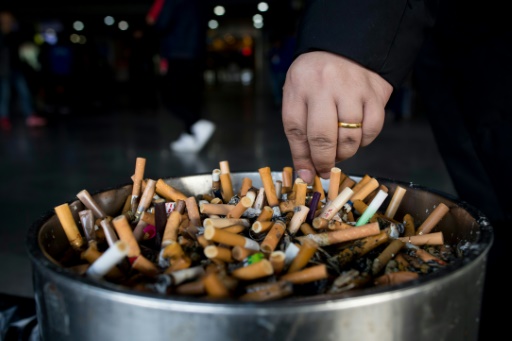Tobacco kills 7 million people every year, wreaks environmental havoc: WHO
(VNF) - Smoking and other tobacco use kills more than seven million people each year, the World Health Organization (WHO) said on Tuesday (May 30th), also warning of the dire environmental impact of tobacco production, distribution and waste.
The U.N. agency said tougher measures were needed to rein in tobacco use, urging countries to ban smoking in the workplace and indoor public spaces, outlaw marketing of tobacco products and hike cigarette prices.
"Tobacco threatens us all," WHO chief Margaret Chan said in a statement. "Tobacco exacerbates poverty, reduces economic productivity, contributes to poor household food choices, and pollutes indoor air," she said.
In a report released ahead of World No Tobacco Day on Wednesday (May 31st), WHO warned that the annual death toll of seven million people had jumped from four million at the turn of the century, making tobacco the world's single biggest cause of preventable death.
And the death toll is expected to keep rising, with WHO bracing for more than one billion deaths this century.
 |
Cigarette butts and other tobacco waste are the largest source of inpidual pieces of litter across the globe, according to the World Health Organization.
"By 2030, more than 80 per cent of the deaths will occur in developing countries, which have been increasingly targeted by tobacco companies seeking new markets to circumvent tightening regulation in developed nations."
Tobacco use also brings an economic cost: WHO estimates that it drains more than USD 1.4 trillion (EUR 1.3 trillion) from households and governments each year in healthcare expenditures and lost productivity, or nearly two per cent of the global gross domestic product.
In addition to the health and economic costs linked to smoking, the WHO report for the first time delved into the environmental impact of everything from tobacco production to the cigarette butts and other waste produced by smokers.
'OVERWHELMING DAMAGING PROCESS'
"From start to finish, the tobacco life cycle is an overwhelmingly polluting and damaging process," WHO Assistant Director-General Oleg Chestnov said in the report.
The report detailed how growing tobacco often requires large quantities of fertilisers and pesticides, and it warned that tobacco farming had become the main cause of deforestation in several countries.
This is largely due to the amount of wood needed for curing tobacco, with WHO estimating that one tree is needed for every 300 cigarettes produced.
WHO also highlighted the pollution generated during the production, transport and distribution of tobacco products.
The report estimates that the industry emits nearly four million tonnes of carbon dioxide equivalent annually - the same as around three million transatlantic flights.
And waste from the process contains over 7,000 toxic chemicals that poison the environment, including human carcinogens, WHO said.
Once in the hands of the consumer, tobacco smoke emissions spewed thousands of tonnes of human carcinogens, toxic substances and greenhouse gases into the environment.
Cigarette butts and other tobacco waste make up the largest number of inpidual pieces of litter in the world, the agency said.
Two thirds of the 15 billion cigarettes sold each day are thrown on to the street or elsewhere in the environment, it said, adding that butts account for up to 40 per cent of all items collected in coastal and urban clean-ups.
WHO urged governments to take strong measures to rein in tobacco use.
"One of the least used, but most effective tobacco control measures...is through increasing tobacco tax and prices," Chestnov said.
In Vietnam, the number of diseases related to cigarette smoke has increased significantly. Experts have said cigarettes are helping cancers to grow.
According to experts, 96.8 per cent of lung cancers patients in Vietnam smoke.
In a recent seminar on throat and lung cancer screening, experts said that the risk of developing lung cancer for smokers is 10 times higher compared to non-smokers. Second-hand smoke also increases the risk of lung cancer by up to 30 per cent.
WHO has selected the theme “Tobacco – a threat to development” for this year’s World No Tobacco Day. The initiative is expected to propose measures that governments and the public should take to promote health and development by confronting the tobacco crisis.
On may 28th, Vietnam launched the national non-smoking week to respond to the World No Tobacco Day. Nearly 2,000 Hanoi students rode bicycles on streets and participated in a flash-mob event to advocate for a non-smoking life./.
Compiled by VNF
Recommended
 Handbook
Handbook
Vietnam Moves Up 8 Places In World Happiness Index
 Handbook
Handbook
Travelling Vietnam Through French Artist's Children Book
 Multimedia
Multimedia
Vietnamese Turmeric Fish among Best Asian Dishes: TasteAtlas
 Handbook
Handbook
From Lost to Found: German Tourist Thanks Vietnamese Police for Returning His Bag
 Handbook
Handbook
Prediction and Resolution for the Disasters of Humanity
 Handbook
Handbook
16 French Films To Be Shown For Free During Tet Holiday In Vietnam
 Handbook
Handbook
Unique Cultural and Religious Activities to Welcome Year of the Snake
 Handbook
Handbook
